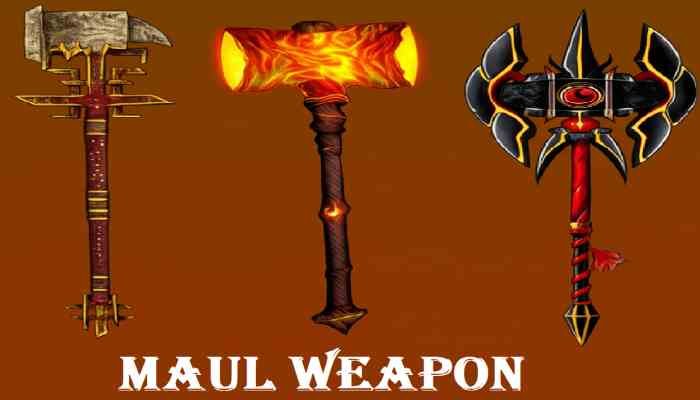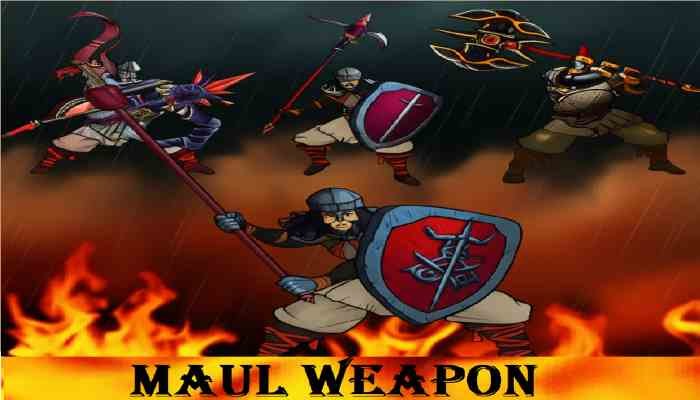Maul Weapon: History, Design, and Fantasy Power 2025

- Introduction to Maul Weapon
- History of the Maul Weapon
- Design and Structure of a Maul
- Types of Maul Weapons Across History
- Maul Weapon in Warfare
- Famous Warriors and Battles Using Mauls
- Maul Weapon in Modern Culture
- Advantages and Disadvantages of a Maul Weapon
- Maul vs. Warhammer: What’s the Difference?
- Training and Techniques for Using a Maul
- Collecting and Reproducing Maul Weapons Today
- Conclusion
Introduction to Maul Weapon
Maul Weapon is a heavy blunt-force weapon with a powerful reputation in history. It looks like a giant hammer with a long handle and a massive striking head. Unlike blades, the maul depends on raw strength and crushing impact instead of cutting edges.
The weapon was designed to smash armor, shields, and bones. Its destructive power made it popular during medieval battles. Soldiers and knights often carried it to fight against well-armored enemies.
Outside the battlefield, the maul weapon was also a practical tool. Workers used it for splitting logs and driving stakes. Its usefulness made it a common object in both war and daily life.
Today, the maul weapon continues to appear in games, movies, and books. Gamers know it as a slow but extremely strong weapon. Historians study it for its battlefield importance. In every form, the maul weapon symbolizes strength, endurance, and unstoppable force.
History of the Maul Weapon
Maul Weapon has a history that goes back to medieval Europe. It began as a tool for laborers who needed something strong to split wood or drive posts. Over time, it was adapted into a battlefield weapon.
During the 14th and 15th centuries, soldiers discovered that the maul could smash armor. Swords and axes often failed against full steel protection, but a heavy maul could break helmets and bones with one hit. This made it a preferred weapon in wars like the Hundred Years’ War.
The weapon required great strength, so only trained warriors could use it effectively. It was especially popular among English infantry who valued its destructive power.
As gunpowder weapons and lighter arms became common, the maul lost importance in war. Still, its image remained powerful. Today, historians, collectors, and game developers keep the legend of the maul weapon alive.
Design and Structure of a Maul
Maul Weapon design is simple but effective. It combines weight, balance, and raw power. The basic structure has two main parts: the handle and the head.
The handle is long, often made from tough wood like oak or ash. Some versions used reinforced iron for strength.
The head is heavy and usually made of iron or steel. It has a flat side for striking and sometimes a pointed side for armor piercing.
The average maul weighed between 5 to 8 kilograms, making it difficult to wield. Unlike swords, which required skill in blade work, the maul relied on brute force.
Another important design element was leverage. The long handle gave the user enough reach and power to swing it with devastating effect. A single blow could crush shields, helmets, and even knock enemies off horses.
This design made the maul weapon one of the most feared anti-armor tools in history.
Types of Maul Weapons Across History
Maul Weapon developed in many forms across regions and cultures. Different societies created variations based on needs and materials.
Some major types included:
Utility Maul – Used by workers for wood splitting and heavy labor.
Battlefield Maul – Designed with reinforced heads for crushing armor.
Flanged Maul – Featured sharp ridges or points to pierce helmets.
Pole Maul – A longer version, giving soldiers extended reach.
Ceremonial Maul – Decorative versions used for rituals or symbolic purposes.
Each type had its strengths. The utility maul showed the tool’s practical side. The battle maul highlighted its role in war. The flanged and pole mauls proved how the weapon evolved to match changing armor styles.
Even today, replicas of these types are made for collectors, museums, and reenactments. The variety of maul weapons proves how versatile and important this heavy tool was in both history and culture.
Read More: Pike Weapon: History, Use, and Legacy in Warfare
Maul Weapon in Warfare
Maul Weapon played a critical role in medieval warfare. Unlike swords, it was not elegant or fast. Instead, it was brutal and destructive.
On the battlefield, the maul was especially effective against knights in heavy armor. A single strike could bend steel and leave enemies unable to fight. Shields and helmets were often useless against its crushing weight.
Infantry soldiers used mauls to break defensive lines. The weapon’s long handle allowed fighters to strike from a safe distance. Cavalry units also feared it, since a powerful swing could unseat a rider.
The maul was not without weakness. It was slow and exhausting to swing repeatedly. Only strong and skilled soldiers could handle it for long battles.
Despite these challenges, the maul remained a feared weapon. It gave ordinary soldiers a chance to defeat armored knights, making it an important equalizer in medieval combat.
Famous Warriors and Battles Using Mauls

Maul Weapon has been linked to legendary warriors and historic battles. Its reputation grew from real events that proved its devastating power.
In the Hundred Years’ War, English longbowmen carried mauls as backup weapons. When arrows were no longer effective, they used mauls to finish battles.
Chronicles mention King Charles VI of France’s soldiers using mauls in 1382 during the Battle of Roosebeke.
Some knights who could not afford expensive swords preferred the maul because of its cost-effectiveness and strength.
Famous figures in fantasy and folklore also used mauls. Characters in Norse legends and modern games are often shown wielding them. The maul became a symbol of raw strength and an equalizer for those who lacked finesse in sword fighting.
Its role in both history and legend ensures that the maul weapon is remembered as one of the most fearsome tools of war.
Maul Weapon in Modern Culture
Maul Weapon has survived in modern times through popular culture. It is no longer used in real combat, but it continues to inspire.
In fantasy games like Dungeons & Dragons, Skyrim, and World of Warcraft, the maul is a popular two-handed weapon. Players love its massive damage output, even if it is slow.
Movies and television also feature mauls in medieval battle scenes. They are often shown as the weapon of choice for strong, fearless warriors. The image of a hero or villain carrying a maul creates a sense of power.
Collectible replicas are sold worldwide for fans and historians. Cosplayers and reenactors often use them in events.
This modern revival proves that the legend of the maul weapon is alive. From history to gaming screens, the maul still stands as a symbol of brute strength and unstoppable force.
Advantages and Disadvantages of a Maul Weapon
Maul Weapon had both benefits and drawbacks. Its design made it powerful, but also difficult to use.
Advantages:
High impact force – Could crush armor and helmets.
Intimidating appearance – Psychological advantage in battle.
Durable build – Strong head and handle for repeated use.
Useful in labor – Worked as a tool outside warfare.
Disadvantages:
Very heavy – Tired the user quickly.
Slow attack speed – Could be avoided by faster enemies.
Requires great strength – Not suitable for all soldiers.
Limited skill use – Depended more on force than technique.
Overall, the maul weapon was a double-edged choice. It offered unmatched destructive power but demanded strength, stamina, and patience from the warrior who carried it.
Maul vs. Warhammer: What’s the Difference?
Maul Weapon is often compared with the warhammer, but they are not the same. Both are blunt weapons, yet their design and use differed.
Here’s a comparison table:
| Feature | Maul Weapon | Warhammer |
|---|---|---|
| Weight | Very heavy (5–8 kg) | Lighter (2–4 kg) |
| Head Shape | Large, flat striking head | Smaller, often spiked |
| Handle Length | Long, for two-handed use | Medium, one or two hands |
| Primary Use | Crushing armor and shields | Piercing and smashing |
| Speed | Slow and tiring | Faster and more balanced |
The maul weapon was the brute-force option, while the warhammer allowed more speed and technique. Both were deadly, but the maul focused purely on raw power.
Training and Techniques for Using a Maul
Maul Weapon required serious training. Unlike swords, it was not easy to control. The weapon’s weight made it dangerous even for the user.
Training focused on strength building. Warriors practiced lifting and swinging heavy logs or stones to build endurance. The goal was to maintain power without tiring too fast.
Techniques included wide swings, overhead strikes, and crushing downward blows. Each movement had to be timed carefully. Missing a strike could leave the user open to attack.
Some soldiers paired mauls with shields or sidearms. Others trained in formations, where maul users broke enemy lines. The key to success was discipline, stamina, and precision.
Without training, the maul weapon was more of a burden than a benefit. But in skilled hands, it became one of the most feared medieval weapons.
Read More: Bloodborne Weapons: Ranking the Finest Tools of the Hunt
Collecting and Reproducing Maul Weapons Today
Maul Weapon collecting has become popular among history lovers and enthusiasts. Replicas are produced by modern craftsmen and sold worldwide.
Museums keep original pieces that survived through centuries. These displays help people understand the design and power of the weapon. Historical reenactments often use replicas to recreate battles, giving audiences a glimpse of medieval warfare.
Collectors enjoy the maul for its unique look and story. Some choose decorative pieces, while others prefer fully functional replicas made from real steel.
Modern blacksmiths also experiment with designs, creating mauls for cosplay, movies, and gaming communities. These reproductions keep the memory of the maul alive, even though it is no longer used in real combat.
The practice shows that the legacy of the maul weapon is not forgotten. It continues to inspire art, history, and fantasy culture across the world.
Conclusion
Maul Weapon is more than a medieval hammer. It is a symbol of strength and history. From its start as a simple tool to its rise as a battlefield giant, the maul changed how wars were fought.
It was a weapon of pure destruction, capable of breaking armor and striking fear into enemies. Though heavy and difficult to use, it gave soldiers a powerful chance against knights.
Today, the maul weapon lives in museums, games, movies, and collector’s homes. It bridges the gap between history and imagination.
In every form, the maul remains a weapon that tells the story of bravery, endurance, and unstoppable force.
FAQs About Maul Weapons
Q1. What is a maul weapon?
A maul weapon is a heavy hammer-like weapon designed to crush armor and shields.
Q2. How is a maul different from a warhammer?
The maul is heavier with a flat striking head, while the warhammer is lighter and faster.
Q3. Was the maul used only in battles?
No, it was also used as a tool for splitting wood and heavy labor.
Q4. Do maul weapons exist today?
Yes, replicas and collectibles exist in museums, reenactments, and gaming culture.
Q5. Why is the maul weapon popular in games?
Because it represents high damage, brute strength, and iconic medieval power.




